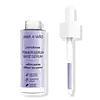What's inside
What's inside
 Key Ingredients
Key Ingredients

 Benefits
Benefits

 Concerns
Concerns

No concerns
 Ingredients Side-by-side
Ingredients Side-by-side

Water
Skin ConditioningButylene Glycol
HumectantAcacia Senegal Gum
MaskingSynthetic Fluorphlogopite
Squalane
EmollientAmmonium Acryloyldimethyltaurate/Vp Copolymer
Hydroxyacetophenone
AntioxidantCellulose Gum
Emulsion StabilisingEthylhexylglycerin
Skin ConditioningTetrasodium Glutamate Diacetate
Benzotriazolyl Dodecyl P-Cresol
UV AbsorberPhenoxyethanol
PreservativeTin Oxide
AbrasiveCI 14700
Cosmetic ColorantCI 77891
Cosmetic ColorantWater
Skin ConditioningGlycerin
HumectantAlcohol Denat.
AntimicrobialIsopentyldiol
HumectantRosa Damascena Flower Water
MaskingPEG-40 Hydrogenated Castor Oil
EmulsifyingPhenoxyethanol
PreservativePolyacrylate Crosspolymer-6
Emulsion StabilisingCaprylyl Glycol
EmollientEthylhexylglycerin
Skin ConditioningHexylene Glycol
EmulsifyingButylene Glycol
HumectantCamellia Sinensis Leaf Extract
AntimicrobialHydroxypropyl Cyclodextrin
MaskingRibes Nigrum Seed Oil
EmollientOctyldodecanol
EmollientLavandula Hybrida Oil
EmollientLeuconostoc Ferment Filtrate
AntimicrobialCarthamus Tinctorius Seed Oil
MaskingOctyldodecyl Oleate
EmollientPropylene Glycol
HumectantDimethicone
EmollientAroma
Sodium Acrylates Crosspolymer-2
AbsorbentOctyldodecyl Stearoyl Stearate
EmollientCaprylic/Capric Triglyceride
MaskingCichorium Intybus Root Extract
MaskingBakuchiol
AntimicrobialLavandula Angustifolia Flower Extract
CleansingAlcohol
AntimicrobialIodopropynyl Butylcarbamate
PreservativeHydrolyzed Opuntia Ficus-Indica Flower Extract
AbrasiveT-Butyl Alcohol
PerfumingPolysilicone-11
Paeonia Suffruticosa Root Extract
Skin ProtectingSorbitol
HumectantHylocereus Undatus Fruit Extract
Skin ConditioningRosmarinus Officinalis Leaf Extract
AntimicrobialSolidago Virgaurea Extract
Skin ConditioningOligopeptide-68
BleachingDecyl Glucoside
CleansingGlycine Soja Oil
EmollientHydrogenated Lecithin
EmulsifyingTocopheryl Acetate
AntioxidantAscorbic Acid
AntioxidantSodium Oleate
CleansingDisodium EDTA
CI 77891
Cosmetic ColorantCI 16035
Cosmetic ColorantMica
Cosmetic ColorantCI 17200
Cosmetic ColorantCI 42090
Cosmetic ColorantWater, Glycerin, Alcohol Denat., Isopentyldiol, Rosa Damascena Flower Water, PEG-40 Hydrogenated Castor Oil, Phenoxyethanol, Polyacrylate Crosspolymer-6, Caprylyl Glycol, Ethylhexylglycerin, Hexylene Glycol, Butylene Glycol, Camellia Sinensis Leaf Extract, Hydroxypropyl Cyclodextrin, Ribes Nigrum Seed Oil, Octyldodecanol, Lavandula Hybrida Oil, Leuconostoc Ferment Filtrate, Carthamus Tinctorius Seed Oil, Octyldodecyl Oleate, Propylene Glycol, Dimethicone, Aroma, Sodium Acrylates Crosspolymer-2, Octyldodecyl Stearoyl Stearate, Caprylic/Capric Triglyceride, Cichorium Intybus Root Extract, Bakuchiol, Lavandula Angustifolia Flower Extract, Alcohol, Iodopropynyl Butylcarbamate, Hydrolyzed Opuntia Ficus-Indica Flower Extract, T-Butyl Alcohol, Polysilicone-11, Paeonia Suffruticosa Root Extract, Sorbitol, Hylocereus Undatus Fruit Extract, Rosmarinus Officinalis Leaf Extract, Solidago Virgaurea Extract, Oligopeptide-68, Decyl Glucoside, Glycine Soja Oil, Hydrogenated Lecithin, Tocopheryl Acetate, Ascorbic Acid, Sodium Oleate, Disodium EDTA, CI 77891, CI 16035, Mica, CI 17200, CI 42090
Ingredients Explained
These ingredients are found in both products.
Ingredients higher up in an ingredient list are typically present in a larger amount.
Butylene Glycol (or BG) is used within cosmetic products for a few different reasons:
Overall, Butylene Glycol is a safe and well-rounded ingredient that works well with other ingredients.
Though this ingredient works well with most skin types, some people with sensitive skin may experience a reaction such as allergic rashes, closed comedones, or itchiness.
Learn more about Butylene GlycolCi 77891 is a white pigment from Titanium dioxide. It is naturally found in minerals such as rutile and ilmenite.
It's main function is to add a white color to cosmetics. It can also be mixed with other colors to create different shades.
Ci 77891 is commonly found in sunscreens due to its ability to block UV rays.
Learn more about CI 77891Ethylhexylglycerin (we can't pronounce this either) is commonly used as a preservative and skin softener. It is derived from glyceryl.
You might see Ethylhexylglycerin often paired with other preservatives such as phenoxyethanol. Ethylhexylglycerin has been found to increase the effectiveness of these other preservatives.
Phenoxyethanol is a preservative that has germicide, antimicrobial, and aromatic properties. Studies show that phenoxyethanol can prevent microbial growth. By itself, it has a scent that is similar to that of a rose.
It's often used in formulations along with Caprylyl Glycol to preserve the shelf life of products.
Water. It's the most common cosmetic ingredient of all. You'll usually see it at the top of ingredient lists, meaning that it makes up the largest part of the product.
So why is it so popular? Water most often acts as a solvent - this means that it helps dissolve other ingredients into the formulation.
You'll also recognize water as that liquid we all need to stay alive. If you see this, drink a glass of water. Stay hydrated!
Learn more about Water